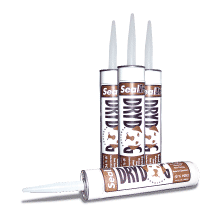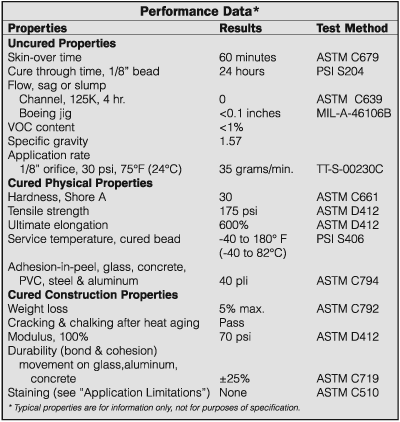
Product description
SealIt XP is a single component, moisture-cure, environmentally
friendly, polyurethane sealant that cures rapidly to
a durable, medium modulus, flexible, weatherproof sealant.
The cured sealant adheres well to most common substrates
such as masonry, concrete, glass and aluminum without
priming and shows excellent adhesion to most types of
plastic.
SealIt XP comes in 10.3 fl. oz. (305 ml) cartridges,
24 cartridges per carton.
Available in Limestone Color.
Basic uses
SealIt XP can be used for exterior and interior caulking
the perimeters of frame openings; expansion, control
and isolation joints; coping and coping to facade joints;
cornice and wash joints; panels; poured-in-place; tilt-up;
underside of precast planks; steps and risers; top of
non-loadbearing walls; glazing, etc. It is also suitable
for various manufacturing uses, such as production of
travel trailers and mobile homes, extruded PVC windows
and doors, and many other OEM applications.
Benefits
• Contains no TDI (toluene diisocyanate) or VOC
(volatile organic solvents).
• Excellent adhesion to wide range of substrates
• Excellent weatherability and durability
• Low odor.
Application limitations
• Do not apply over damp or contaminated
surfaces or in hot, humid weather conditions
as
the sealant will bubble or foam if applied
during
these conditions.
• Do not apply to absorptive surfaces such as
marble, limestone, or granite without prior
testing
for discoloration or staining.
• Use only at temperatures of 40°F (4°C)
and rising.
• Maximum joint width = 1-1/2”.
Applicable standards
SealIt XP meets or exceeds the requirements of Federal
Specification TT-S-00230C, Type II, Class A; ASTM C920-87
Type S, Grade NS, Class 25, use NT, G, M, A, and O;
AAMA 802.3 and 805.2; CAN/CGSB 19.13-M87.
Installation
Joint design:
The width of the joint should be a minimum of 4 times
the anticipated movement. In joints up to 1/2”
wide, the depth of the sealant should be equal to the
width, but not less than 1/4”. In joints wider
than 1/2”, the depth should be maintained at 1/2”.
Maximum joint width is 1-1/2” for a SealIt XP
installation .
For butt joints, see DryDog's Joint Design Chart for
recommended joint designs for specific building materials.
Lap shear joints should have a width of at least twice
the anticipated movement.
Surface preparation:
Joints to receive sealant must be sound, smooth, uniform
in dimensions and free from defects and foreign materials.
They must also be clean, dry, free of frost and all
contaminants, such as curing compounds, sealers (waterproofing),
coatings, etc. To test adhesion, apply a sealant bead
and allow to cure thoroughly. Then pull one end of the
bead to test adhesive strength.
Back-up material:
The purpose of back-up material is to regulate the depth
of the joint; to provide a surface against which the
sealant is compressed when tooled, thus promoting better
adhesion to the side walls; and to provide a non-adhering
back surface, precluding the possibility of a three-sided
joint. Where back-up material is not necessary or where
a type is used that does not have release properties,
a bond breaker tape should be used. Closed cell polyethylene
foam back-up material is recommended. It should not
be punctured, twisted or excessively stretched during
installation, nor should it be compressed more than
50% of its original diameter. Open cell backer rod is
compatible with all DryDog sealants as long as it remains
dry.
Tooling:
In vertical and horizontal joints, tooling is absolutely
necessary to aid contact with the substrate, eliminate
air bubbles and give a highly desirable concave appearance.
Cleaning:
Immediately remove all excess sealant and smears adjacent
to joints with xylol as work progresses. For equipment
clean up, use xylol or its equivalent. These solvents
are flammable. Keep away from sparks, flames, excessively
high temperatures or other ignition sources. Refer to
manufacturer's MSDS for proper safe handling precautions.
Shelf life:
One year from date of shipment when stored in original,
unopened container in a dry area at temperatures below
80°F (27°C).
Maintenance
If the sealant is damaged and the bond is intact, cut
out the damaged area and recaulk. No primer is required.
If the bond has been affected, remove the old sealant,
clean and prepare the joint in accordance with the instructions
under “Surface Preparation” and recaulk.

|
 |